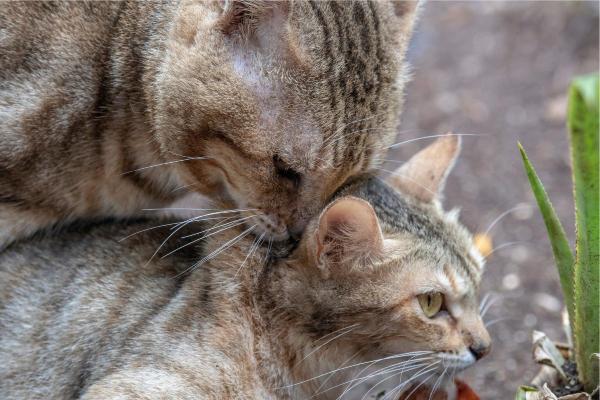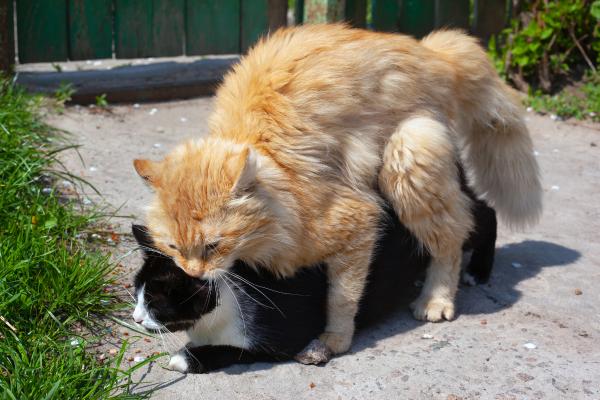My Neutered Cat Still Humps



See files for Cats
We don't expect a neutered cat to hump because their sexual organs have been removed. Whether it is another cat, an object or even their guardian, humping is often seen as only a sexual release for frustrated cats. For sexually intact cats, mounting will occur during copulation when a female cat is in heat. When a cat cannot access a potential mate, we may see the cat humping objects as a way to vent frustration. These behaviors are caused by sex hormones which are produced to facilitate copulation. Neutering in the form of spaying or castration removes the main organs which produce these hormones. For this reason, we need to look at other reasons why my neutered cat still humps.
At AnimalWised, we provide the main reasons for mounting in sterilized cats. We discover when this behavior does not require intervention or when it might be a sign of a problem.
What is neutering in cats?
Neutering is the process of removing the sexual organs of an animal. For male cats, this means the removal of the testes via castration. For females, a procedure known as an ovariohysterectomy is carried out. This is more commonly known as spaying.
Many cat guardians will wonder when is the best time to neuter their cat. There is a common misapprehension that female cats should become pregnant once and then be neutered. This is a complete myth and will not affect the cat's wellbeing at all. For female cats, spaying should be carried out before their first heat period at around 8 weeks of age. Male cats should be castrated before they reach sexual maturity, usually before 5 months of age.
The benefits of neutering cats are numerous. Not only does it commonly prevent mounting behavior, but the cat will have a better chance for health and wellbeing. It reduces the risk of various hormone-related diseases, including fatal uterine cancers in females. Very importantly, it reduces unwanted feline pregnancy. This helps to lessen the burden of care for cats in the world which already need homes and families.
In terms of behavior, neutering should stop sexual behaviors in both male and female cats. Especially when carried out before they reach sexual maturity, neutering will stop female cats going into their heat cycle. This means they will have no desire to mate and males will not be interested in copulation with them.
Despite neutering reducing and often eradicating mounting behaviors, it can still appear. We look at the reasons neutered cats hump in the following sections.
Hormonal residue
Spaying and neutering a cat removes their sexual organs, something can results in their body being largely unable to produce sex hormones. The main sex hormones are estrogen in females and testosterone in males, created largely by the ovaries and testicles, respectively. These hormones control the animal's impetuses and will result in behaviors including humping. This mounting behavior does not necessarily occur with a cat of the opposite sex.
Generally speaking, neutered cats do not have the urge to mate. When a cat is spayed or neutered, there may still be certain levels of sex hormone in the body. Male cats may even still have some sperm for a short period of time. For this reason, cats may still hump soon after neutering, but this behavior should slow down and stop eventually.
There are other tissues in the body which can create the aforementioned sex hormones, but they do so to a very small degree. It is unlikely the amount produced will affect their behavior, including the cat humping objects or animals. However, in a few cases, there may be some increase in this production. This could be due to the following:
- Incomplete removal of gonad tissue: while the castration and spaying procedures are generally highly safe and effective, there can be rare instances where some small remnants of gonadal tissue are inadvertently left behind during surgery. These residual tissues can continue to produce hormones in very small quantities, but it could be enough to influence humping behaviors.
- Adrenal gland production: the adrenal glands are responsible for producing hormones like cortisol, can produce small amounts of sex hormones like testosterone in some cases. This is known as adrenal hyperplasia or hyperadrenocorticism. While it's not common, it can result in low-level hormone production. Another very unlikely reason your cat humps is due to an adrenocortical tumor which can influence behavior, among other symptoms[1].
- Individual variation: some cats may have variations in their anatomy or hormone production that make them more prone to hormonal influence even after neutering. Individual differences in metabolism and hormone regulation can play a role.
When remnants of gonadal tissue might not cause a problem, they do promote certain health risks. We can see this if a spayed cat develops pyometra, since this uterine infection cannot occur if there is no tissue to become infected. We should mention this behavior to our veterinarian during a checkup.
Learn more with our article on why a spayed cat is in heat.

Play behavior
While it is correct to associate humping with sexual behaviors, this is not the only reasons cats mount other cats or objects in the home. Mounting can also be a way to play and express other aspects of their feline nature. Cats use play to express this nature, using toys, other animals or even their human guardians as participants. Humping and mounting is often part of this behavior, especially in younger cats.
One of the reasons for this is mock aggression or play dominance. This is a behavior when the cat uses play to mimic hunting behaviors of their wild counterparts. It doesn't mean the cat actually thinks they are hunting the object, animal or guardian. It is simply an expression of a behavior which is used in the wild to practice catching prey. In this way, it is not a sexual act, despite appearances.
This type of mounting and humping can be especially common in males that were neutered later in their development. By this stage, they may have already started to exhibit mounting behavior. Even though they are neutered, they may carry out humping simply because it is a learned behavior that they enjoy.
Stress or anxiety
Since it is a behavior which is used to relieve frustration, it is possible the cat still humps because they can use it as a coping mechanism. It is unclear as to whether a neutered cat will derive pleasure from this behavior, but it is a possibility. Regardless, the action itself can be enough to help the cat cope with stress and anxiety.
Stressed cats will carry out various behaviors for seemingly no purpose. They are known as stereotypies and exist to help them release frustration when they do not know what else to do. For cats that were neutered later in their development, they will likely have enjoying humping and mounting, so it is understandable they may seek enjoyment from this behavior when experiencing stress.
The causes of stress in cats are numerous, but they are often related to changes in their routine. This could be the presence of another animal, a move or even something as small as changing their cat food. This can be exacerbated by problems such as poor socialization, emotional trauma or other emotional stressors. The cause of the stress needs to be determined and addressed through behavioral therapy.
If poor socialization is the cause, our related article explains how to socialize an adult cat.
Disease or illness
In addition to gonadal tissue remnants, there may be other medical reasons for a cat humping or mounting. There are various diseases which affect a cat's genitals which may result in them humping to relieve the symptoms. For example, a cat with a urinary tract infection may feel a sting in their urethra and hump to relieve this pain. This can also result in other symptoms, such as a male cat pushing out their penis to lick it or a female cat repetitively licking her private area.
Other diseases can result in skin irritation of the area which the cat may try to relieve via humping. This can include dermatitis, abscesses on the cat's skin or other skin diseases. We should take the cat to a veterinarian to confirm the diagnosis. They will be able to provide the correct corresponding treatment. For example, bacterial urinary infections will require antibiotic treatment.
Personality
Our final reason why a neutered cat is still humping is because they enjoy it. Some cats will have the kind of personality which results in them enjoying this behavior. This is especially common in cats neutered after they have reached sexual maturity. These cats have learned to enjoy this behavior and may still carry it out for this reason.
Some cats may also mount to show dominance to other cats in the home. For this reason, we may only see a cat mounting another cat since they have been recently introduced. In these cases, the existing cat wants to show the other cat they are in their territory. Mounting is a behavior which can show control over the other animals.
Can a neutered cat impregnate another?
Despite the other benefits, the main purpose of neutering a cat is to act as a contraceptive. If the animal does not have the organs to create the gametes required for fertilization, new cats cannot be born. For this reason, a neutered cat male cat cannot be able to impregnate a sexually intact female and a spayed female cannot be impregnated by a sexually intact male.
The only exceptions are if the copulation occurs recently after the procedure and the male still has sperm in their body. In this case, although unlikely, it is possible mounting could lead to fertilization. Another rare exception is when the spaying or castration has not been carried out properly. This could mean there are still reproductive cells in the body, but this is very unlikely.

What to do if a neutered cat is still humping
In the majority of cases, you will not need to do anything. If the cat is simply expressing their personality and enjoying their mounting behavior without causing harm, we should let them continue it.
When the problem is related to a physical disease or behavioral problem, they will need to be addressed. We will first need to go to a veterinarian to rule out the possibility of disease or to diagnose the problem. Once this has been determined, the treatment can be administered.
For cats with behavioral or emotional problems such as stress, we will need to address the specific problem. The help of a feline ethologists can be particularly beneficial as they can both assess the cat's individual needs and provide tailored solutions to those needs. Generally speaking, you can do the following to help a neutered cat that is still humping:
- Provide adequate environmental enrichment for cats to prevent boredom, frustration or stress
- Spend time and play with them
- Monitor the exits in case they try to escape
- Go to an ethologist to evaluate a personalized action plan
- Spay and neuter other cats in your care
Humping and mounting is not the only behavior which can be expressed by neutered cats. Learn more about why a cat keeps kneading with our related video below:

If you want to read similar articles to My Neutered Cat Still Humps, we recommend you visit our Heat category.
1. Sumner, J. P., Hulsebosch, S. E., Dudley, R. M., Miller, M. L., & Hayes, G. M. (2019). Sex-hormone producing adrenal tumors causing behavioral changes as the sole clinical sign in 3 cats. The Canadian veterinary journal = La revue veterinaire canadienne, 60(3), 305–310.
- da Silva, L. D. M. (2020). Considerations regarding cat reproduction. Animal Science, 30 (4), 57-69.







